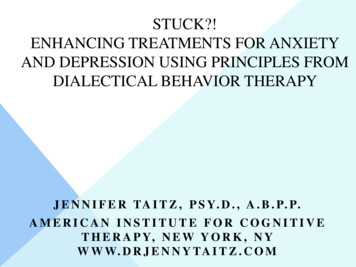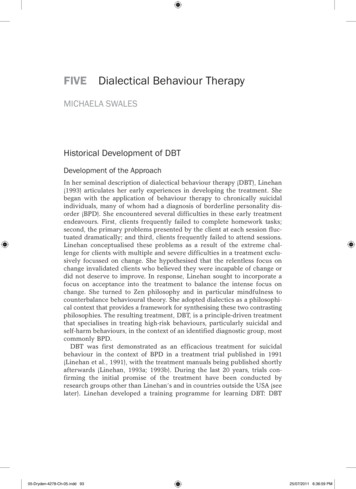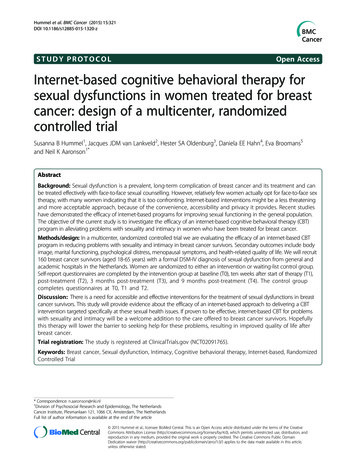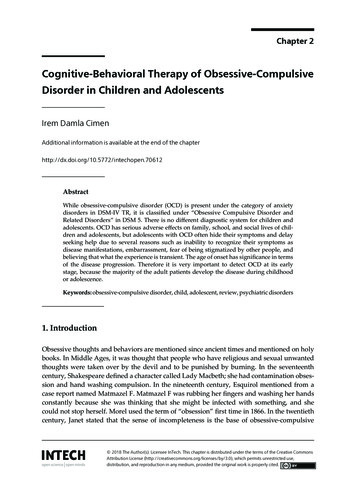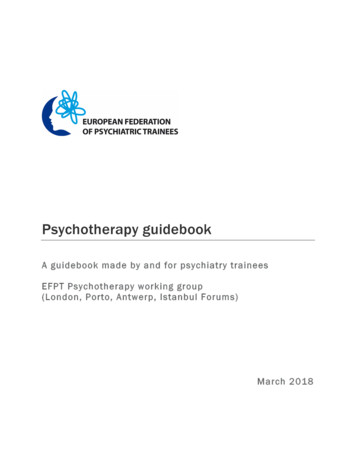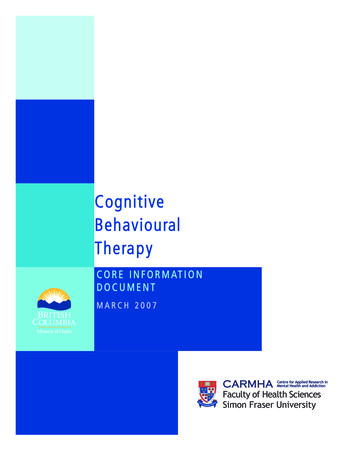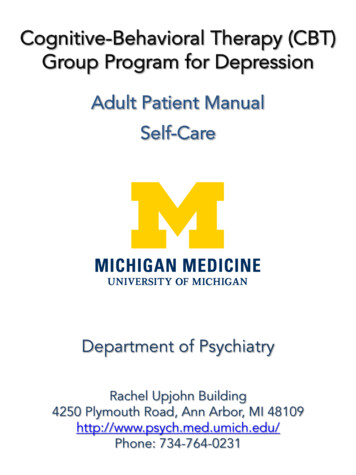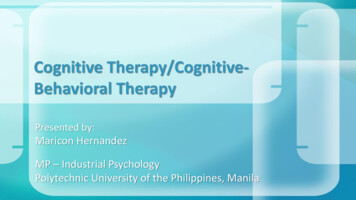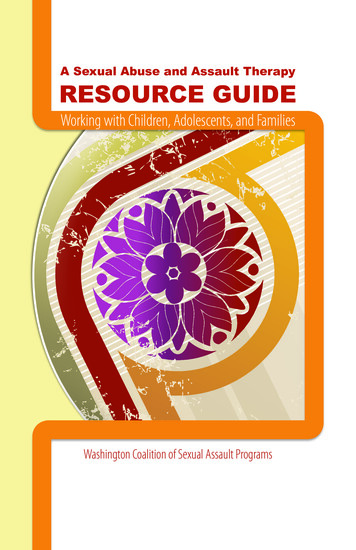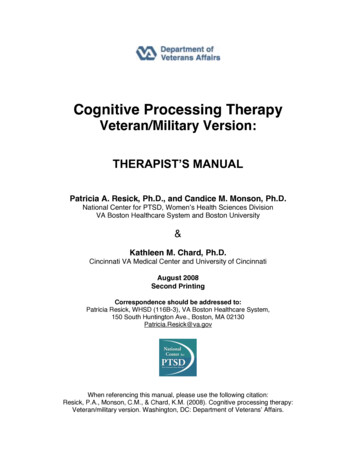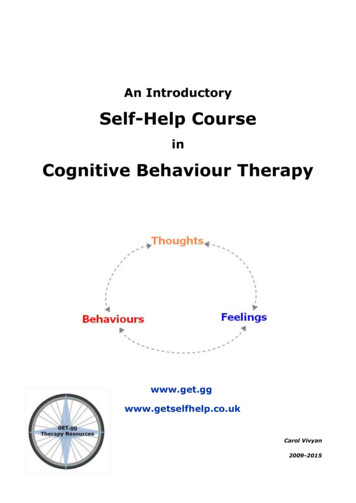
Transcription
An IntroductorySelf-Help CourseinCognitive Behaviour TherapyHwww.get.ggwww.getselfhelp.co.ukCarol Vivyan2009-2015
1This mini 7-step self-help course includes an introduction to techniques which couldbe useful for all, but professional help should be sought for complex or long-standingproblems. The course is, with many other additional resources, also available onlineat duction to Cognitive Behaviour TherapyIdentifying Thoughts, Feelings & BehavioursVicious CycleUnderstanding the links between Thoughts,Feelings & Behaviours – Depression, Anxiety, AngerVicious CogsEmotions and their associated thoughts, bodyreactions and behavioursDealing with Negative EmotionsMaking Changes – BehavioursWeekly PlannerACE LogTreatment PlanProblem Solving WorksheetCommunication StylesMaking Changes – ThoughtsAbout Automatic ThoughtsUnhelpful Thinking HabitsFinding Alternative ThoughtsFact or Opinion?Different PerspectivesChallenging our ThoughtsThe Court CaseThought Record SheetPositive AffirmationsThe Worry TreeSTOPP WorksheetDefusing from our ThoughtsMindfulnessACT WorksheetSTOPPDefusion TechniquesImagery for Self-HelpSleeping WellWhat now?Positive Steps to 041424344454753545556606264Further copies of this guide, and of additional worksheets and leaflets in italics above, can bedownloaded freely (in Adobe document format) from www.getselfhelp.co.uk/freedownloads.htm Carol Vivyan 2009-2015www.get.gg
2Cognitive Behaviour Therapy - how it can helpCognitive Behaviour Therapy is a form of psychotherapy that talks about How you think about yourself, the world and other peopleHow what you do affects your thoughts and feelingsCBT can help you to change how you think ("Cognitive") and what you do("Behaviour)". These changes can help you to feel better. Unlike some of theother talking treatments, it focuses on the "here and now" problems anddifficulties. Whilst it is often useful to discuss the past and understand how ourpasts have influenced our lives and how problems have arisen, CBT mostlyfocuses on looking for ways to improve your mental wellbeing now.CBT says that it's not the event which causes our emotions, but how weinterpret that event - what we think or what meaning we give that event orsituation.For instance, if someone you know passes you in the street withoutacknowledging you, you can interpret it several ways. You might think theydon't want to know you because no-one likes you (which may lead you to feeldepressed), your thought may be that you hope they don't stop to talk to you,because you won't know what to say and they'll think you're boring and stupid(anxiety), you may think they’re being deliberately snotty (leading to anger).A healthier response might be that they just didn't see you.Another example may be someone who's depressed might wake up in themorning and think: "This is going to be another awful day", "I'm going to Carol Vivyan 2009-2015www.get.gg
3mess up again", or "What's the point of anything?", which will make them feeleven more depressed (feelings), and may prompt them to pull the covers overtheir head and stay in bed (behaviours). It's very likely that this will increasetheir negative thoughts, which in turn will increase the feelings of depression,and make them even less likely to get out of bed. A vicious cycle is the result- continuing to think and act the same way will help maintain our depression(diagram below).A vicious cycle of Anxiety might look something like this: Carol Vivyan 2009-2015www.get.gg
4CBT can help you to break these vicious cycles of negative thinking, feelingsand behaviour. When you see the parts of the vicious cycle clearly, you canchange them - and therefore change the way you feel. It can also be useful tolook at the way our thoughts and feelings affect our bodies, and the physicalsensations we can experienceDifferent emotions are often associated with particular types of thoughts:CBT aims to get you to a point where you can "do it yourself", and work outyour own ways of tackling problems. CBT has often been described as guidedself-help, and this self-help course will help you learn how CBT can help you.The following self-help steps will enable you, with or without the help of atherapist or mental health professional, to gain some useful insights and beginto address and work through your problems.There are many more resources available on the websitewww.get.ggHHwww.getselfhelp.co.uk Carol Vivyan 2009-2015www.get.gg
5Step 1Identifying Thoughts, Feelings & BehavioursNow we can start to look at what's helping to keep your problems going.Let's use a recent example, when you've been distressed - perhaps somethinghas happened in the past week or so when you've felt particularly anxious,angry, or depressed.What was the situation? What happened? When did it happen? What elsewas going on? Was it a situation that you often find yourselfin? Who were you with?What thoughts or images went through your mind justbefore or during that time? What disturbed you? If you hadthat thought, what did that mean to you, or what did that sayabout you or the situation? If your thought was a question, try toanswer it. Carol Vivyan 2009-2015www.get.gg
6What distressing emotion/s did you feel? What else?E.g. Anger, anxiety, terror, rage, depression, frustration, guilt,shame, irritable.What did you notice in your body?E.g. In anxiety and anger (and excitement) the body's adrenaline canresult in us feeling physical sensations which can include: heartpounding or racing, palpitations, rapid breathing, difficulty breathing,light-headed, dizzy, shaky, sweaty, hot, red, pins & needles, tense orsore muscles, urge to go to the toilet, butterflies in the tummy, warmuncomfortable feeling in the abdomen or chest, difficulty concentrating, lumpin throat. This is the fight & flight response - the body's survival mechanismwhich helps us escape or to stand up to the threat at times of real danger.The body is unable to differentiate between a real or imagined danger, so thealarm signal is pressed and activated regardless.In depression, we can feel tired, lethargic, exhausted, experience appetite andsleep changes, aches and pains, headaches, digestive changes (e.g.constipation), agitation and feel unable to settle, experience lack of interest insex, and have slow movement or speech. Carol Vivyan 2009-2015www.get.gg
7What did you do? What didn't you do? How did you cope?Examples include:(Anxiety): Stayed home, left wherever you were or felt the urgeto leave, didn’t talk to anyone, avoided eye contact, fiddled witha pen, sat in a corner, didn’t go out, chose to shop at less busytimes, went to local corner shop instead of the big supermarket,distracted yourself (TV, radio, kept busy etc), urge to go (orwent) to toilet, looked for reassurance, drank more, smoked more, ate more(or less), disturbed sleep.(Depression): Stayed in bed, pulled covers over your head, didn't go out, satand stared, watched television, didn't answer the phone, turned down an invitefrom a friend, didn't go to work, ate more (or less), slept more (or less), pacedaround , kept starting to do things but couldn't finish, no interest in others, nointerest in sex, no interest in anything.(Anger): shouted at someone, hit out, screamed, had a go at someone,sulked, criticised others (or had urge to do those things), used put-downs andthreats, bottled it up, lost control.Practise noticing these thoughts, feelings and behaviours - the moreyou practise, the more you will notice them. The more you noticethem, the more you will be able to make helpful and effective changes.This Vicious cycle form will help you practise. Photocopy the form (ordownload more copies from the website) and write down at least onesituation every day for the next few days. Vicious Cycle Carol Vivyan 2009-2015www.get.gg
SITUATIONWhen? Where? What?Who with?THOUGHTS & IMAGES8What did I think or imagine at that time? What went through my mind?What did that say or mean about me or the situation?BEHAVIOURSWhat did I do at that time? What did I avoid doing? Whatwas my automatic response? What would a fly on the wallhave seen me do?FEELINGSEmotions / MoodsWhat emotion did I feel at the time? How intense was thatfeeling? (0-100%)Physical / Body sensationsWhat did I notice in my body? What did I feel? Where did Ifeel it? Carol Vivyan 2009-2015www.get.gg
9Step 2Understanding the Links between Thoughts, Feelings & BehavioursSo far, we have looked at vicious cycles and learned how thoughts, feelingsand behaviours are linked and each one affects the others.If we use the depression example from that page, we see that on waking in themorning, 'Dave' had thoughts that included "There's no point", and "I'll onlymess up again". If we think those thoughts and believe them, there is everychance that we are going to feel depressed. If we think those thoughts andfeel depressed, then it's likely that we would be sorely tempted to pull thecovers over our head and stay in bed.How does doing that affect the way Dave feels and thinks? Hmm. Staying inbed might mean that his thoughts get carried away and he continues to thinkthat way, making him feel even worse, and even more likely to stay in bed. Avicious cycle. This is a typical vicious cycle of depression:DEPRESSIONDepression can happen to anyone - and does happen to one in fourof us over our lifetimes. Different factors that make it more likely tohappen, include biological make-up, upbringing, or reaction to lifeevents. What keeps it going though, is how we deal with thosethings. The way we think and what we do affects the way we feel.Depression is often accompanied by other feelings such as guilt, shame, angerand anxiety. Carol Vivyan 2009-2015www.get.gg
10Thoughts that occur in DepressionPeople who are depressed tend to think very negatively about themselves, thefuture and the world around them. It can be like seeing life through"gloomy specs". Everything is hopeless - nothing can changeI'm useless, worthlessIt's all my faultThe world is a terrible place - everything goes wrongWe can dwell on these thoughts repeatedly, mulling over things, askingourselves why, thinking regretful things about the past, what we should orshouldn't have done.Physical Sensations & Depression Tiredness, fatigue, lethargyDifficulty concentrating or rememberingSleep changes (sleep more or less)Eating changes (eat more or less)Lose interest in hobbies, activities, sexBehaviours & DepressionBecause of the tiredness, difficulty sleeping and eating, and negative style ofthinking, we tend to do less and less. We stop doing the things we used to doand enjoy. It could get so bad that we can't even go to work, or do things athome. We want to stay in bed, or stay at home doing very little. We mightisolate ourselves from friends and family.ANXIETYAnxiety is the body's way of responding to being in danger.Adrenaline is rushed into our bloodstream to enable us to runaway or fight. This happens whether the danger is real, orwhether we believe the danger is there when actually there isnone. It is the body's alarm and survival mechanism. Primitiveman wouldn't have survived for long without this life-saving response. Itworks so well, that it often kicks in when it's not needed - when the danger isin our heads rather than in reality. We think we're in danger, so that's enoughto trigger the system to go, go, go! People who get anxious tend to get intoscanning mode - where they're constantly on the lookout for danger, hyperalert to any of the signals, and make it more likely that the alarm system willbe activated. Carol Vivyan 2009-2015www.get.gg
11Thoughts that often occur in Anxiety include our overestimating orexaggerating the actual threat, and underestimating or minimising our abilityto cope: I'm in danger right now The worst possible scenario is going to happen I won't be able to cope with itPhysical Sensations - The Adrenaline ResponseWhen there is real, or we believe there is a real, threat or danger, our bodies'automatic survival mechanism kicks in very quickly. This helps energise us tofight or run away ('fight or flight response'). We will notice lots of physicalsensations, which might include: Heart racing - This helps to take the blood to where it is most needed –his legs so that he can run faster (flight); his arms so that he can hit out(FIGHT); his lungs to increase his stamina. At the same time blood istaken from the places it is not needed for example fingers, toes andskin. These changes cause tingling coldness and numbness. Breathing gets faster - This helps the bloodstream to carry oxygen tothe arms, legs and lungs. This will give him more power. The sideeffects may include chest pain, breathlessness and a choking feeling. Asthere is a slight drop in the blood and oxygen being sent to the brain hemay feel dizzy or light headed, he may experience blurred vision. Muscles tense and prepare - The large skeletal muscles tense andcreate power, this may cause pain, aching and shaking. Sweating - Sweating helps to cool the muscles and the body. It helps tostop them from overheating. Sweating can also make us more slipperyto our enemies! Pupils dilate - This lets more light into his eyes so his overall visionimproves. Side effects may include sensitivity to light or spots before hiseyes. Digestive system slows down - These are not important while indanger and so are slowed down then the saved energy goes to where itis most needed. Side effects may include nausea, butterflies and a drymouth. More alert - He will be concentrating on looking for danger, much lessable to concentrate on anything else. He will be waiting for something tohappen. This is the basis of the way we worry.Behaviours might include: Avoiding people or places Not going out Going to certain places at certain times, e.g. shoppingat smaller shops, at less busy times Only going with someone else Escape, leave early Go to the feared situation, but use coping behaviours to get you through:examples include: self talk, holding a drink, smoking more, fiddling withclothes or handbag, avoiding eye contact with others, having an escapeplan, medication. These are called 'safety behaviours'. Carol Vivyan 2009-2015www.get.gg
12Safety behaviours can also help to keep your anxiety going. Whilst youdepend on them to help you cope, you don't get to find out that without them,the anxiety would reduce and go away on its own.Whilst avoiding people or situations might help you feel better at that time, itdoesn't make your anxiety any better over a longer period. If you'refrightened that your anxiety will make you pass out or vomit in thesupermarket aisle, you won't find out that won't actually happen, because youdon't go. So the belief that it will happen remains, along with the anxiety.Vicious Cycle of AnxietyWe all feel anxious some times. A certain amount of anxiety helps us to bemore alert and focused. For example just prior to an exam, a few examnerves have a positive effect - motivating us, helping us focus our thoughts onthe job in hand, making us more alert. Too much anxiety, or constantly beinganxious, is unhealthy and detrimental to our lives and relationships. Carol Vivyan 2009-2015www.get.gg
13ANGERWhat is Anger?Anger is a result of thinking that we have been unfairly treated ordisrespected, or that we or others have broken or fallen short of ourrules or expectations, there is an injustice, and we won't stand for it.Thinking this way leads us to feel angry, which stimulates the body'sadrenaline response which is our body's way of helping us to cope with eitherfighting, or running away ('fight or flight' response). We respond to thosethoughts and feelings, by acting, or feeling an urge to act, in threatening oraggressive ways.To help overcome a persistent anger problem, we need to understand what weare REALLY angry about - which may well be NOT what we are directing ouranger towards at that time. It is often due to something related to somethingfrom our past, and the current situation FEELS similar, so it triggers our angryresponse now.Thoughts that often occur: I'm being treated unfairly I'm being disrespected This is injust! I won't stand for itPhysical Sensations - The Adrenaline ResponseWhen there is real, or we believe there is a real, threat or danger, or webelieve we need to defend or stand up for what we believe, our bodies'automatic survival mechanism kicks in very quickly. This helps energise us tofight or run away ('fight or flight response'). We will notice lots of physicalsensations, which might include: heart racing or pounding - enabling good blood supply around our bodies breathing quickly - allowing more oxygen around the body tense muscles - a state of readiness to fight or flee shaking hot, sweating light-headed stomach churning or butterflies fist or teeth clenchingBehaviours might include: staring & angry facial expression aggressive body posture attacking hitting out (or urge to hit out) arguing shouting or snapping at others running or storming away staying silent (maybe inwardly seething) sulking Carol Vivyan 2009-2015www.get.gg
14The Angry CycleWe all feel angry some times. Some people tend to become angry easily (a"short fuse"), and some have problems controlling their anger. Anger hasconsequences, and they often involve hurting other people - more usually theirfeelings, but sometimes physically. Anger can cause problems in our personallives, and affect work and study. After an angry outburst, we can think verycritically of ourselves and our actions, leading us to feel guilty, ashamed andlower our mood, which might result in our withdrawing from others, notwanting to do anything (see depression cycle).SummaryIn CBT, we aim to break those cycles by changing something - what we thinkor what we do. We might start by looking at what might be easiest to change.Perhaps in this case, it might be easiest to change what we do.How would Dave have felt if he had got up anyway, in spite of how he wasfeeling. Maybe ate some breakfast, had a shower, got dressed, and perhapswent out for a walk. How would that affect his depression? What would thatdo to the way he was thinking?It's very likely that his mood would have improved, and that he would havestarted to think a little more realistically. He might have even enjoyed his day,or got a sense of achievement from having done something.Have a look at what you've written down on your sheets of several examples ofdistressing situations (Step 1 practice). What links can you see between whatyou think and what you do, and how they affect the way you feel.In the next step, you'll be starting to make some changes that will work foryou.If you have a problem other than depression, anxiety or anger, please see the note on page 63 Carol Vivyan 2009-2015www.get.gg
15VICIOUS COGSIn order to make effective positive change in our mental wellbeing, it is essentialto look at the factors which help to keep our problem going. Once we'veidentified those factors, we can then target each factor and start to make positivechanges.Cogs is a variation of the “vicious flower”.Using the example of a simple clockworkmechanism, we can see how the smallercogs keep the large central cog turning.If there's a problem with any of the cogs,then the whole mechanism will grind to ahalt.We can therefore use this process to helpus deal with our mental health problem.If our main problem is "anxiety", then wecan write "anxiety" inside the large centralcog. Then we can identify each factorthan helps keep the anxiety going.In order to reduce and deal with the anxiety, we need to target and make positivehelpful changes in each of those smaller cogs.EXAMPLE COGS Carol Vivyan 2009-2015www.get.gg
16VICIOUS COGS WORKSHEETWrite the name of your problem (e.g. anxiety, depression, OCD etc) in thelarge middle cog. You can also substitute an unhelpful belief (e.g. “I’m afailure”) in the large middle cog.Write all the factors (unhelpful things you do or unhelpful ways of thinking) inthe smaller surrounding cogs.Take each smaller cog, and identify ways of making positive changes. You canwork up to these changes gradually, so it may help to write down the steps onthe way to achieving your goal for each cog. Carol Vivyan 2009-2015www.get.gg
17EmotionEmotions and their associated thoughts, body reactions and behavioursThoughtsBody reactionBehavioursAngryfrustrated, irritated,impatient, resentful, enraged,peed off, fury, insultedAnxiousnervous, on edge,apprehensive, scared,frightened, panicky, terrified,petrifiedDepressedsad, down, despairing,hopeless, gloomy,miserable, sorrowful,unhappy, dismayedAssume the worstProblem is enormousOthers are unfair I’ve been disrespected,treated unfairly, used I’ve been let down It’s not fair! I won’t stand for itAdrenaline response: Tense Fired up Energised, breathing andheart rate increase Difficulty concentrating FightConfrontArgueMake lots of noise!SulkSnap, swear, shoutSarcastic, patronisePut downsThreat: Overestimate dangerUnderestimate ability to cope I’m in great danger rightnow The worst possible thing isgoing to happen I won’t be able to cope withitAdrenaline response: Tense, shaky, sweaty,hot, Energised, breathing andheart rate increase Difficulty concentrating Avoid people orplaces (in order toavoid feeling anxious) Fidget Escape / run away Coping or safetybehavioursNegative focus. Themes of loss,hopelessness, negative view ofself I’m worthless Nothing’s going to change I’ve lost.Slowed down or agitated Tired, lethargic Constipated Memory & concentrationproblems Appetite & sleep changes Loss of interest: hobbies,sex Restlessness Do lessTalk lessEat less or moreSleep less or moreIsolate and withdrawRuminate on negativethoughts Carol Vivyan 2009-2015www.get.gg
18Dealing with Negative EmotionsWhat emotion am Ifeeling? What can Inotice in mybody?Where do Ifeel it?What am I thinking?EmotionDepression I’m useless, I’mworthless.Everything is hopelessAnxiety Something bad isgoing to happen.I won’t be able tocopeAnger It’s notfair.Others are bad.I won’t stand for it. BodyFatigueSlowed downDo lessStay esponse –Body’s alarmsystem.Energised forfight or flightAdrenalineresponse –Body’s alarmsystem.Energised forfight or flightSTOPP! Take a breath.www.getselfhelp.co.uk/stopp.htmWhat am I reacting to? What’s pressing mybuttons here? What does this situation mean tome or say about me? Is this fact or opinion?Where is my focus of attention?How could I see things differently? What would Isay to someone else in this situation? Howimportant is this? Is my reaction in proportion tothe event?Take the helicopter view! Do what works!What will be the consequencesof my action?What will be the most effectiveaction?What will be best for me, forothers and for this situation?Is this in keeping with myprinciples & values? Where do you feel this emotion inyour body? If this feeling had acolour, what would it be? Whatshape is it? How big is it? Whatconsistency is it?If you felt better: What colourwould it be? What about theshape? The size? The consistency?Notice that feeling now.Thinking differentlyDoing differentlyImageryIt’s okay to feel sad about this situation, butI can get through it.I’m looking through those ‘gloomy specs’again.This doesn’t mean I’m a worthless person.What would be a more helpful way oflooking at things?If I do something anyway – I’ll feel better.Do things anyway – in spiteof how I’m feeling.Get up. Get out.Do something enjoyable oruseful.Be with or contact others.Focus attention outside of meand my situation.In your mind’s eye, see yourselfdoing and enjoying the thingsyou used to or would like toenjoy doing, and successfullydoing what you need to do.Is this threat a real one or is it really boundto happen? Am I exaggerating the threat?Am I misreading things?I feel bad, but that doesn’t mean thingsreally are so bad.I can cope with these feelings, I’ve gotthrough it before.What would someone else say about this?What would be a more helpful way oflooking at things?What am I reacting to? What’s pressing mybuttons? Am I over-reacting? Is myreaction in proportion to the actual event?How important is this?I feel like I’m being unfairly treated, butmaybe they didn’t mean it that way. Am Imisreading things?What’s the best thing to do here?How will doing this affect mein the long term? Don’tavoid situations – go anyway.Problem solve or make plansif necessary. Take thingsslowly or gradually.Focus attention outside of me– external rather thaninternal focus.Imagine yourself coping in asituation that you feel anxiousabout. See the situationthrough to a successfulcompletion.Take a breath. Do the bestthing – best for me, forothers and for the situation.Walk away?When feeling calm, if stillappropriate, do somethingabout it in a calm, nonaggressive but assertive way.Visualise orange for positiveenergy. Breathe in orange, andbreathe out blue/black.Visualise blue for calm.Breathe in blue and breathe outred.Visualise yourself handling thissituation in a calm, nonaggressive but assertive way,respecting the rights andopinions of everyone involved.Visualise blue for calm, orgreen for balance. Breathe ingreen/blue & breathe out red. Carol Vivyan 2009-2015www.get.gg
19Step 3Making Changes - BehavioursChanging what we normally do can greatly affect they way we feeland think.When you look at your 'Vicious Cycle' form/s where you wrotedown your thoughts, feelings (emotions and physical sensations)and behaviours, notice particularly what you wrote for'behaviours'. Very often we react automatically, withoutconsidering our actions or the consequences of them. What helped you cope and get through it?What didn’t I do or what did I avoid doing?What automatic reactions did I have?What would other people have seen me doing?What were the consequences of what I did? What happened laterbecause of it? Did it affect the way I felt later?Now ask yourself, what could I have done differently? What would someone else have done in that situation? (it might help tothink about particular people that you know, and what they might havedone differently)Have there been times in the past when I would have done somethingelse?If I had paused, and taken a breath, what would I have done?Write down several options that you might have done differently if it hadoccurred to you, then ask yourself: If I had tried that, how would the situation have been different?How would it have affected what I felt?How would it have affected what I thought?Would it have been more helpful or effective for me, another person orfor the situation?What would the consequences have been of doing something differently?Dealing with Distressing Situations:Practise and learn to STOP and take a breath before consideringwhat action to take. Just simply pausing and taking a breath whenfeeling distressed can help us to see the situation more clearly, andhelp us decide what action to take.Choose to do what works! Carol Vivyan 2009-2015www.get.gg
20When considering your options, ask yourself: Will it be effective and appropriate?Is it in proportion to the event?Is it in keeping with my values and principles?What will be the consequences of my action?What is best for me and most helpful for this situation?Some suggestions for coping with crises and distressing emotions: Do something different (to what you normally do)Pause, take a breathMindfulness - learn Mindful Breathing (pages 45-49)Focus your attention fully on another activity - Mindful activity (page 46)Relaxation techniques - try lots and find one that works for you(www.getselfhelp.co.uk/relax.htm)Put on some music - sing and dance along, or just listenattentively (use music that is likely to help you feel yourdesired emotion – avoid sad songs if you're depressed)( www.cwgsy.net/private/get/music.htm )Meditation or Prayer( www.getselfhelp.co.uk/meditation.htm )Help othersBe with others - contact a friend, visit familyTalk to someoneGrounding techniques - look around you, what do you see, hear, smell,sense? Hold a comforting object.Physical exercise - walk, swim, go to the gymEngage in a hobby or other interest - if you don't have one, find one!What have you enjoyed in the past? What have you sometimes thoughtabout doing but not got around to?Write down your thoughts and feelings - get them out of yourheadJust take one step at a time - don't plan too far aheadPamper yourself - do something you really enjoy, or somethingrelaxingPositive self-talk - encourage yourself, tell yourself: I can do this, I amstrong and capable - find an affirmation that works for you (even if youdon't believe it at first!). Write it down and memorise it for when youneed it. See Affirmations on page 41Do something creativeUse Safe Place Imagery (page 54)Tell yourself: "This will pass, it's only temporary". "I've gotthrough this before, I can do it now". When we're goingthrough a tunnel and become fearful of being trapped, there'sno point in stopping - we just have to carry on in order to reach the endof the tunnel. That light is there, and waiting!HHHHH HHH HH Carol Vivyan 2009-2015www.get.gg
21Activity & Physical ExerciseJust increasing our activity and exercise levels can make anenormous impact on our mood by: Making us feel better about ourselvesMaking us feel less tiredMotivating us to do moreImproving our ability to think more clearlyHelping us think about something other than focussing on our unhelpfulthoughtsUsing up the adrenaline resources created by anxiety and angerIncreasing motivationGiving us a sense of achievementEnjoymentBeing with other peopleStimulating the body to produce natural anti-depressantsMaking us generally more healthyStimulating our appe
Cognitive Behaviour Therapy - how it can help Cognitive Behaviour Therapy is a form of psychotherapy that talks about How you think about yourself, the world and other people How what you do affects your thoughts and feelings CBT can help you to change how you think ("
